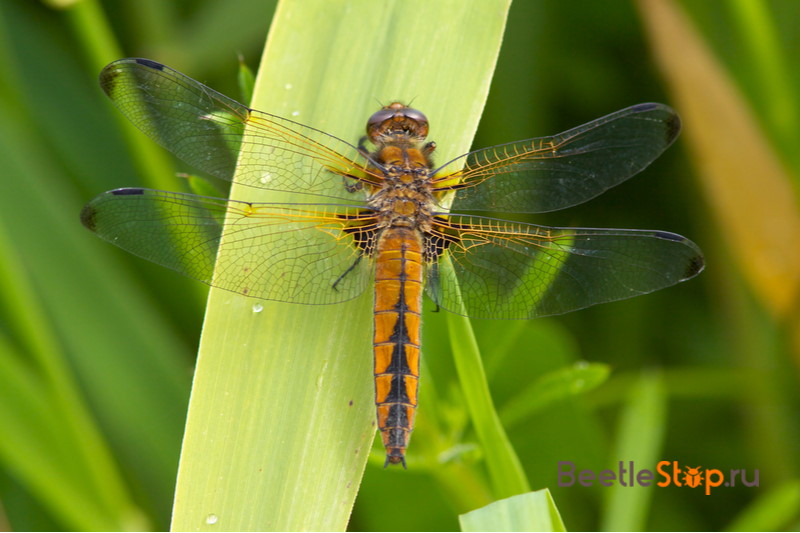Red dragonfly - flat-bellied predator
The genus flat-bellied (Libelulla) or libelulla includes about 30 species. For insects, a characteristic brown, yellow and reddish color. Adult males are covered with a blue waxy coating. Dragonflies are very attached to their habitats, strictly protect the site from strangers. In the European part of Russia there are 3 types of flat-bellied fish: a dragonfly is flat, a dragonfly is four-spotted and a red dragonfly. Their larvae or mollusks live in clean stagnant water, they like to dig into the silt.
Morphological description of the species
The red dragonfly (Libelulla fulva) or the flat-bellied ginger belongs to the family of real dragonflies, the genus of flat-bellied. A medium-sized body - the total length is 42-45 mm, 26-28 mm fall on the abdomen. Wingspan 70-78 mm. On the sides of the head are large, partially touching eyes. between them is a black membrane. Faceted eyes consist of 50 thousand tiny ommatidia, which together provide an excellent overview of the world. In a miniature triangle on the forehead are simple eyes.

The lower lip is black, the antennas are thin and short. The body is tan, the chest is covered with hairs. Old insects are much darker than young ones. The flat-bellied abdomen has sexual dimorphism - the male’s abdomen covers up with blue plaque with age, the color does not change in the female. From 4 to 10 a black stripe is present on the abdomen of both sexes. Both pairs of wings are transparent with a complex venation pattern. At the base of the hind wings is a triangle-shaped dimming. The veins at the leading edge of the female’s wings are painted red.
Distribution area
The species Libelulla fulva is common in Europe. To the east, its habitat extends to the Caspian Sea and the Caucasus, to the north - to Finland. The flat-bellied redhead is found in Denmark, Germany, Greece, Great Britain, Ukraine, Turkey. Population density differs significantly by region. In the 80s, the number of dragonflies decreased on the Iberian Peninsula, but over the course of two decades, the number returned to normal.
Habitats and lifestyle
Years of insects occur at the end of May and the entire summer period. Flat bellies settle near standing reservoirs - ponds, lakes, swamps, and are found on the banks of slow rivers. They select areas with rich vegetation in water and on land. Males have a developed territorial instinct. They jealously guard the borders of the site, letting only females pass during the mating season. Dragonflies are active predators. They fly perfectly, performing aerobatics in the air. Prey (flies, midges, mosquitoes) has no chance to escape from the hunter's strong jagged jaws.
Small insects are eaten on the fly, large prey, captured by limbs, is absorbed sitting on plants. Flat bellies are extremely voracious, catch insects per day, the mass of which exceeds several times their own. Dragonflies prefer flying in hot sunny hours, in the evening they sit on reeds or other coastal plants, spending the night in a kind of numbness.
Information. The flight speed of the flat-bellied ginger reaches 50 km / h.
The mating of males and females occurs on the broad leaves of reeds or reeds. At the tip of the male’s abdomen there are tick-shaped appendages with which he holds the partner by the neck.The female bends the abdomen and selects a spermatophore from the fossa in the third segment of the partner's abdomen.
Nymph development
Females lay eggs in streams and other bodies of water with a slow course. For their offspring, the presence of silt or clay deposits at the bottom is important. Females of the flat-bellied ginger have no ovipositor, eggs are sent directly to the water with a blow of the abdomen. Males usually do not accompany them during the laying of eggs. The incubation period of the luggage that descended to the muddy bottom of the reservoir is about 1 month.
Nymphs have a massive abdomen, hairy body, short limbs. They are very different from adults. Red dragonfly larvae do not have external caudal gills. Their breathing occurs with the help of gill outgrowths inside the hind gut. Predatory nymphs feed on live prey, which they have in wait for hours in ambush. They prey on daphnia, water donkeys and other invertebrates. There is a special mask device for catching food. The movable lower lip is stretched when prey appears, after capturing it returns to its original position. The development of offspring lasts 2 years. during this time, the larvae molt 10 times. At the last age, their body length is 23-28 mm.
The final metamorphosis occurs on land. The larva climbs a twig near the pond and sheds its brown skin. A young slender dragonfly appears.

